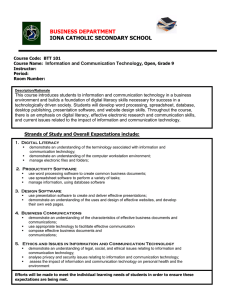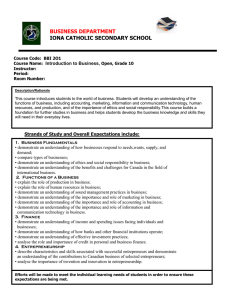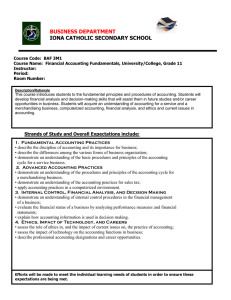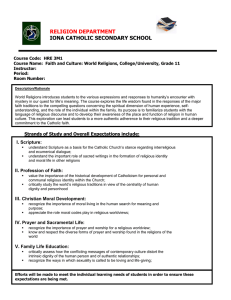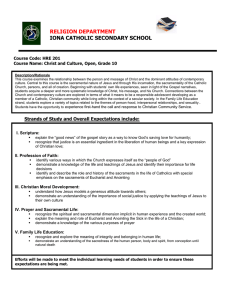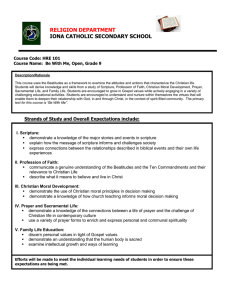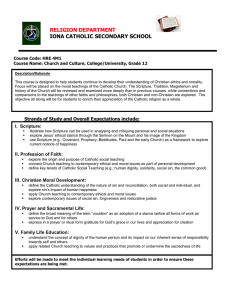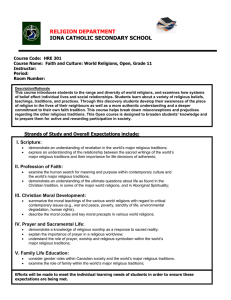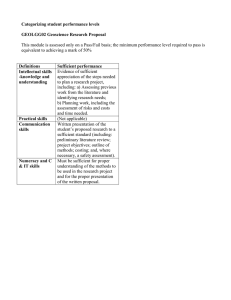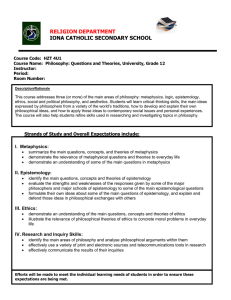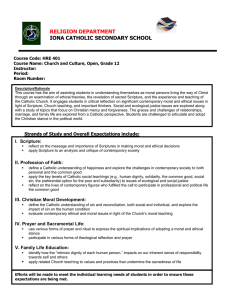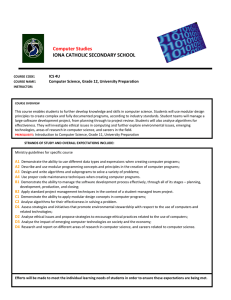IONA CATHOLIC SECONDARY SCHOOL BUSINESS DEPARTMENT Business Leadership: Management Fundamentals,
advertisement
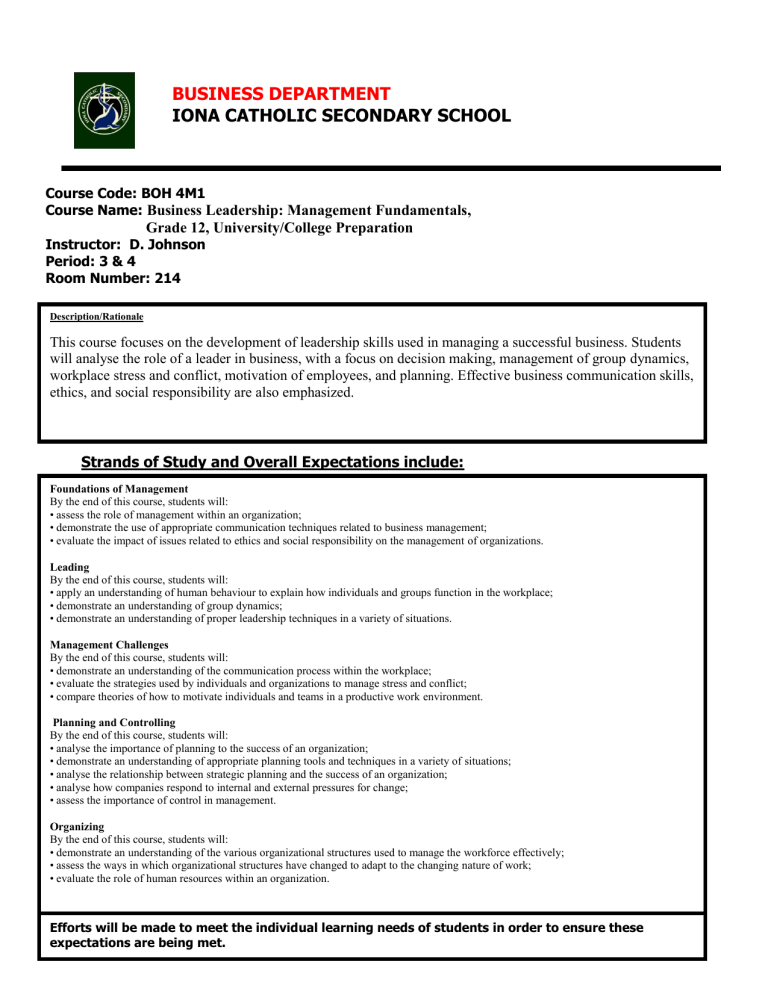
BUSINESS DEPARTMENT IONA CATHOLIC SECONDARY SCHOOL Course Code: BOH 4M1 Course Name: Business Leadership: Management Fundamentals, Grade 12, University/College Preparation Instructor: D. Johnson Period: 3 & 4 Room Number: 214 Description/Rationale This course focuses on the development of leadership skills used in managing a successful business. Students willStrands analyse the role of a leaderand in business, withExpectations a focus on decision include: making, management of group dynamics, of Study Overall workplace stress and conflict, motivation of employees, and planning. Effective business communication skills, ethics, and social responsibility are also emphasized. Strands of Study and Overall Expectations include: Foundations of Management By the end of this course, students will: • assess the role of management within an organization; • demonstrate the use of appropriate communication techniques related to business management; • evaluate the impact of issues related to ethics and social responsibility on the management of organizations. Leading By the end of this course, students will: • apply an understanding of human behaviour to explain how individuals and groups function in the workplace; • demonstrate an understanding of group dynamics; • demonstrate an understanding of proper leadership techniques in a variety of situations. Management Challenges By the end of this course, students will: • demonstrate an understanding of the communication process within the workplace; • evaluate the strategies used by individuals and organizations to manage stress and conflict; • compare theories of how to motivate individuals and teams in a productive work environment.NM Planning and Controlling By the end of this course, students will: • analyse the importance of planning to the success of an organization; • demonstrate an understanding of appropriate planning tools and techniques in a variety of situations; • analyse the relationship between strategic planning and the success of an organization; • analyse how companies respond to internal and external pressures for change; • assess the importance of control in management. Organizing By the end of this course, students will: • demonstrate an understanding of the various organizational structures used to manage the workforce effectively; • assess the ways in which organizational structures have changed to adapt to the changing nature of work; • evaluate the role of human resources within an organization. Efforts will be made to meet the individual learning needs of students in order to ensure these expectations are being met. Course Breakdown Resources: The course will use a variety of resources, including textbooks (Management Fundamentals – Cdn Edition, and Organization Behaviour – Managing People and Organizations – Cdn Edition), video, CD-ROM, Internet Applications and a variety of print sources. UNITS OF STUDY: Foundations of Management Leadership Evaluation Structure:: Knowledge/Understanding Thinking Communication Application Management Challenges Planning & Controlling 30% 25% 20% 25% The above is reflected both in the term work (worth 70% of the final mark) and the summative work (worth 30% of the final mark). Summative work consists of the Final Exam (30%). Organizing Evaluation Policy Students will be assessed & evaluated according to the work produced & skills displayed. Methods of providing feedback will include assessing work in process & evaluating completed assignments, tests, co-operative learning activities, simulations and presentations. Peer & self-evaluations will also be utilized. Student marks will be determined by evaluating process & product according to 4 categories & 4 levels. Please see the chart below for specific skills and key words used to determine student competency in the different categories. Category Knowledge/Understanding: Knowledge of content and understanding of content. Thinking: Use of planning skills, processing skills and critical/creative thinking skill. Communication: Expression and organization of ideas and information and use of conventions vocabulary, and terminology of the discipline in oral, visual, and written forms, including electronic forms; communication for different audiences and purposes in oral, graphic, and written forms, including electronic forms. Application: Application and transfer of knowledge and skills; Making connections within and between various contexts. Level 1: Level 2: Level 3: Level 4: 50-59% 60-69% 70-79% 80-100% Limited display of: Some success in: -knowledge and understanding -knowledge and understanding -critical and creative thinking skills and/or processes -critical and creative thinking skills and/or processes -conveying of meaning through various forms -conveying of meaning through various forms -knowledge and skills to make connections between various contexts -knowledge and skills to make connections between various contexts Considerable display of: -knowledge and understanding Thorough understanding of: -knowledge and understanding -critical and creative thinking skills and/or processes -critical and creative thinking skills and/or processes -conveying of meaning through various forms -conveying of meaning through various forms -knowledge and skills to make connections between various contexts -knowledge and skills to make connections between various contexts Feedback will also be provided for student learning skills. Skills like working independently, team work, organization, work habits and homework, and initiative are assessed independently student achievement and will be conducted through the use of a rubric indicating specific criteria to be achieved to receive each of the following letter grades: E –Excellent G – Good S – Satisfactory N - Needs Improvement Other Evaluation Issues LATE ASSIGNMENTS The due dates for major assignments will be clearly articulated by the teacher when the task is assigned. The teacher will establish a deadline and an acceptance period of 2 school days following the deadline. The teacher will also allow for submission of assignments before the deadlines of the acceptance period for the purpose of assistance in revising. If a student does not hand in the assignment by the deadline, a mark reduction will be applied to the assignment submitted thereafter up to a total of 10%. If the assignment is not submitted by the end of the acceptance period the student will receive a mark of zero. Refer to The Student Handbook 2011-12 for further details. INCOMPLETE ASSSIGNMENTS Assignments will be graded according to the extent with which they meet the criteria established in the rubric or evaluation structure. MISSED TESTS . Teachers will give the class ample notice for up-coming tests/evaluations. It is the responsibility of the student to make arrangements for an alternative assessment date (which may not be during class time) with the teacher before the scheduled time for the test/evaluation. If a test is missed due to a legitimate reason, verification (note only to be handed in on the day of the student’s return) from a parent/guardian must be given to the subject teacher indicating that the parents are aware the student has missed a test. If a test is missed as a result of truancy, a mark of zero will be assigned with no opportunity for a re-write. PLAGIARISM in any form reflects academic dishonesty and will result in a mark of zero for the assignment in question. Refer to The Student Handbook for further details. ATTENDANCE It is the responsibility of each student to be punctual and in attendance, with proper materials, at all classes and scheduled activities. Students who miss classes may put their credit in jeopardy. It is the student’s responsibility to catch up on missed work when absent.
